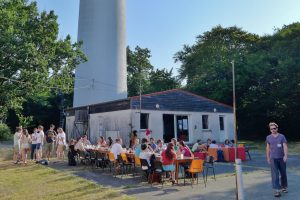Carsten Brühl provides his impressions of his visit at the 13th student meeting “Ecology and Behaviour” at the Centre d’Etudes Biologiques in Chizé, France.
At the SETAC annual meeting 2016 I met Héloïse Guillot, presenting a poster of her PhD work on pesticide exposure of snakes. While discussing her results, Héloïse invited me to the student meeting “Ecology and Behaviour” to give a talk on my work in terrestrial ecotoxicology. Due to the meeting’s name, I agreed immediately, to see and meet a different crowd from ecotoxicology.
The study center at Chizé is part of the University of La Rochelle and situated in the south of France, close to Niort. After a quick train ride, the heat at Niort train station struck me and around 15 other conference participants, among them another “senior” researcher, Frédéric Méry from University Orsay. We were chauffeured to a beautiful small village close by with a frog concert included at night times.
The conference at Chizé was organized by PhD students for PhD students. A mixed crowd from all over Europe and also Africa, America and Asia presented and discussed their results to an audience of 80 participants. The conference started with a movie on a large artic sea bird project that was discussed as an example of science communication with the public. In the following days, the themes went around intra- and interspecific interactions, communication, demography, and included also ecophysiology and ecotoxicology. The wide range of subjects could also be seen in the plenaries that were given by Frédéric Méry on Drosophila and their interaction with individuals with cancer (Touch me, touch me not, impact of social interactions on individual behavior), Marta Manser on communication in meerkats (The evolution of variation in structure and function in mammalian vocalisations), Elisa Thébault on network modelling (The structure and stability of networks with antagonistic and mutualistic interactions), as well as Jon Aars on polar bear demography in Svalbard (Population demography of the Barents Sea polar bears). The presentations of the PhD students were fresh and lively high level performances and the following discussions were directed to details of the results and included constructive comments and ideas that were followed up in coffee and lunch breaks. Even conversations around tasteful dinners ranged around all these subjects and the planning of PhD after-lives.
I thank all the organisers and especially Héloïse for the invitation and their perfect conference preparation that left no open wishes. This conference is highly recommended to PhD students, since it is an inspiration to get so many different insights and fresh and raw scientific results to digest and to meet a nice international crowd in a casual and relaxed atmosphere.
Meet the people! A clip about the meeting:
https://vimeo.com/222844908/3fdb3ac386

